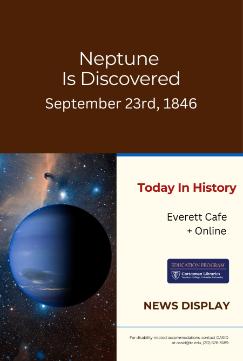Today In History: Neptune Is Discovered

Where does the energy of Neptune's winds come from? Apparently, Neptune gets 2.7 times as much heat from its own interior as it does from the Sun. Why Neptune's internal heat is so high is still a puzzle.
Even more surprising is the fact that Neptune has a tornado that looks like Jupiter's Great Red Spot and that is located at just abut the same spot on the planet's surface. Neptune's tornado is smaller than Jupiter's, because Neptune itself is smaller but it makes Neptune look just as Jupiter would look if that giant planet shrank. Neptune's tornado is blue, of course, and it might be called the Great Dark Spot...
-- Isaac Asimov, How Did we Find Out About Neptune? (p.51)
On September 23rd, 1846, German astronomer Johann Gottfried Galle identified Neptune as the eighth planet, using the Fraunhofer telescope at the Berlin Observatory. French astronomer and mathematician Urbain Le Verrier calculated its predicted position and British mathematician and astronomer John Couch Adams then verified it. While Italian astronomer, physicist, and engineer Galileo Galilei had observed it as far back as 1612, he did not recognize it as a planet due to its slow motion compared to the quicker stars.
Distant Neptune is the farthest known planet from the Sun -- 2.793 billion miles away from it, and it is also fourth largest planet in the Solar System, with a diameter four times wider than that of the Earth. The only planet not visible to the naked eye, Neptune is massive, dark, and cold --an icy blue giant with a 16 hour-day and a year equivalent to about 165 Earth years.
Neptune is named after the Roman god of the sea, its 16 moons after Greek sea gods and nymphs, and its short-lived, thin and clumpy rings after its discoverers. As old as 4.5 billion years, it is not considered hospitable to life, though scientists speculate on the existence of a hot, high-pressurized ocean beneath Neptune's cold clouds; missions such as Voyage II, which launched in 1977, conducted research and exploration to provide key data on its atmosphere, rings, and moons, including the backward orbiting Triton. The Big Blue Planet, with its excessive winds and internal heat source, remains mysterious and puzzling.
The following articles are drawn from Proquest Historical Newspapers, which informs and inspires classroom teaching and learning.
- Holden, P. E. S. (1900, Nov 04). End of the Century Papers: Discovery of Neptune Results in Photography Astronomy and the Telegraph Composition of the Sun. The Nashville American (1894-1910)
- A Famous Astronomer: The Romance of Neptune's Discovery. (1910, Jul 12). The Scotsman (1860-1920)
- First to Observe Neptune: Johann Gottfried Galle, German Astronomer Dies in Postdam. (1910, Jul 12). The Sun (1837-)
- Beyond Neptune: Is There a Distant Giant? (1928, Apr 02) The Manchester Guardian (1901-1959)
- Three Planets Discovered in 30 Centuries: Neptune Sighted in 1846 By Two Scientists, Uranus in 1781 By Englishman Others Known to Ancients Many Minor Bodies Found, First By Piazzi in 1801 the Ninth Planet's Approximate Position. (1930, Mar 14). New York Herald Tribune (1926-1962)
- Many Names Urged for the New Planet: Custom, However, Probably Will Cause Mythological Name to Be Given. Leverrier Incident Cited Neptune Was Called After Him at First, But Storm of Protest Caused It to Be Changed. (1930, Mar 23). New York Times (1923-)
- Sawyer, K. (1989, Aug 20). In Quest for Knowledge, Voyager Speeds Toward Neptune: Voyager Heads for Closest Look at Huge Neptune. The Washington Post (1974-)
- Unlocking the Secrets of Neptune: Dr Ian Elliott, an Astronomer at Dublin's Dunsink Observatory, Outlines the Mysteries and Enigmas of Neptune Which It Is Hoped Voyager II Will Help to Unravel. (1989, Aug 25). The Irish Times (1921-)
- MacRobert, A. M. (1993, Aug 23). Uranus, Neptune Are Neighbors. Boston Globe (1960-)
- Narlikar, J. V. (1996, Jun 08). Discovery of Neptune and the Search for New Planets. The Times of India (1861-)
Tips:
- Asimov, Isaac, and Erika W. Kors. How Did We Find out about Neptune? Walker, 1990. Curriculum ; QB691 .A84 1990.
- The Discovery of Neptune 1846. 1901. e-book.
- Kennett, Carolyn. Uranus and Neptune. First edition, Reaktion Books Ltd, 2022. e-book.
- Lang, Kenneth R. The Cambridge Guide to the Solar System. Second edition, Cambridge University Press, 2011. e-book.
- National Research Council (U.S.). Committee on Planetary and Lunar Exploration. Exploring the Trans-Neptunian Solar System. 1st ed., National Academy Press, 1998. e-book.
- Simon, Seymour. Neptune. Morrow Junior Books, 1991. Curriculum ; QB691.S56 1991.

Images:
- Eight Planets, FreeRange Stock.
- Neptune, Canva.
Need to keep current, look to the past, teach a topic? The Everett Cafe features daily postings of news from around the world, and also promotes awareness of historical events from an educational context. Be sure to check additional Cafe News postings on the library blog.

